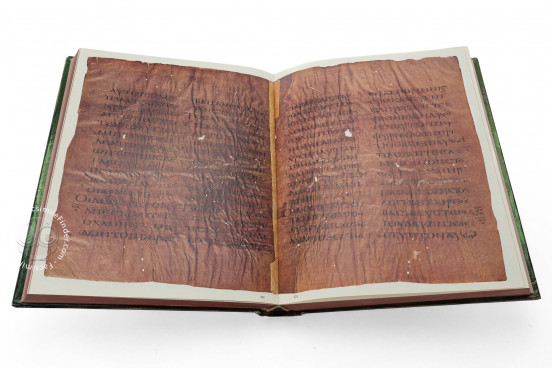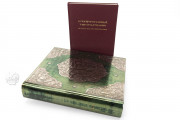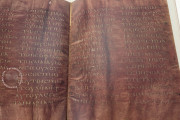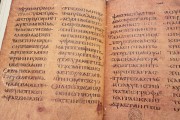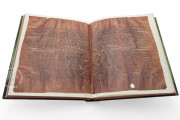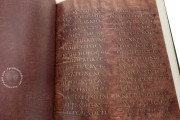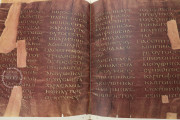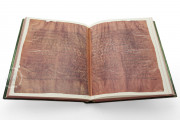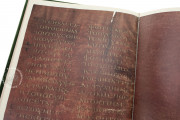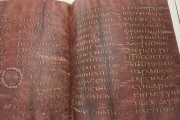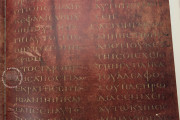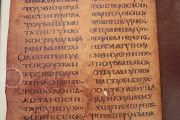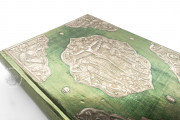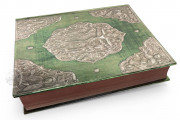The Purple Codex of Saint Petersburg—or Codex Petropolitanus Purpureus—is a substantial fragment of a deluxe Gospel book, the Christian Bible's accounts of the life of Christ attributed to Saint Matthew, Mark, Luke, and John. It takes its nickname from the city where the lion's share (182 leaves) of the fragment is preserved. The text is written in stately Greek Uncial in silver and gold on purple-dyed parchment. Copied in Syria in the late sixth century, the manuscript is a witness to the Byzantine textual recension of the New Testament.
Early manuscripts of the New Testament in the original Greek are the subject of intense interest, and biblical scholars first examined portions of the Purple Codex in the seventeenth century. Its 231 surviving leaves constitute about half of the complete Gospel book.
Conspicuous Luxury
The text is written in two columns in very large Uncial, the spacious Greek Majuscule script with all letters of nearly equal height. The principal text is written in silver (now oxidized to black). Running titles and sacred names (nomina sacra) in the text—usually abbreviated and including the name of Jesus and Greek words for God, Lord, and Savior—are in gold.
The Purple Uncials
The St. Petersburg manuscript is one of the sixth century's five "purple uncials"—manuscripts of the Gospels written in Uncial script on purple-dyed parchment. The others include the Sinope Gospels (Paris, Bibliothèque nationale de France, MS Suppl. grec. 1286) and the Rossano Gospels. It has been determined—at least for the Morgan leaf of the Purple Codex of Saint Petersburg—that lichen was used to color the parchment.
Byzantine Text-Type
The Purple Codex belongs to the "Byzantine" text family, as distinct from the Alexandrian and Western text-types. The Byzantine text-type developed after the others and came quickly to dominate. The Eastern Orthodox Church uses it, and it was the basis for the earliest printed Greek New Testaments.
The surviving leaves are:
- Petersburg, National Library of Russia, MS Gr. 537 (182 leaves)
- Patmos, Monastery of St. John the Theologian, MS 67 (33 leaves)
- Vatican City, Biblioteca Apostolica Vaticana, MS Vat. gr. 2305 (6 leaves)
- London, British Library, MS Cotton Titus C.xv, fols. 2-5 (4 leaves)
- Vienna, Österreichische Nationalbibliothek, Cod. Theol. gr. 31, fols. 25-26 (2 leaves)
- Thessaloniki, Museum of Byzantine Culture, ΒΧφ 1 (1 leaf)
- New York, Morgan Library & Museum, MS M.874 (1 leaf)
- Athens, Byzantine and Christian Museum, 862 (= Fragment 21) (1 leaf)
- Lerma, Castello Spinola (1 leaf)
Broken Up in the Middle Ages
The manuscript was dismembered in the Middle Ages, and reports concerning the provenance of the various portions of the fragment are confusing and conflicting. Portions of the fragmentary manuscript seem to have been discovered in Sarımsaklı (Cappadocia, Türkiye). The leaves in St. Petersburg were purchased on behalf of Nicholas II (1868-1918), Emperor of Russia, in 1896, for the Imperial Public Library. The Imperial Public Library was renamed the Russian Public Library in 1918, and it was known from 1932 to 1937 as the Saltykov-Shchedrin State Public Library and is now the National Library of Russia.
The leaves in the Biblioteca Apostolica Vaticana first appear in a library inventory of 1596/1597. Tradition holds that they were a gift to Pope Innocent VIII (1432-1492) from the royal family of the Crusader kingdom of Cyprus. The leaves in the British Library entered the British Museum library in 1753 as part of Robert Cotton's (1571-1631) collection. They were transferred to the British Library upon its establishment in 1973.
The leaves in the Österreichische Nationalbibliothek were bound with the Vienna Genesis by 1664. The leaf in the Museum of Byzantine Culture is said to have been brought to Greece in 1922; the Hellenic Archaeological Service purchased it in 1966. The leaf in the Morgan Library & Museum (then the Pierpont Morgan Library) was purchased in 1955 from Stanley Rypins (1891-1971).
We have 1 facsimile edition of the manuscript "Purple Codex of Saint Petersburg": Ho Porphyrous Kōdix tōn euangeliōn Patmou kai Petroupoleōs facsimile edition, published by Militos, 2002
Request Info / Price
